The Relation between Concrete, Mortar and Paste Scale Early Age Properties
Abstract
1. Introduction
2. Research Significance
3. Materials and Methods
3.1. Materials and Compositions
3.2. Preparation of Test Specimens and Fresh Properties Testing
3.3. Test Methods
3.3.1. Temperature and Electrical Conductivity Sensor System
3.3.2. Ultrasonic Method
3.3.3. Compressive Strength and Tensile Strength
3.3.4. Static Modulus of Elasticity, Poisson’s Ratio and σ-ε Behaviour in Compression
4. Results and Discussion
4.1. Fresh Properties of CBMs
4.2. Time-Dependent Temperature and Electrical Conductivity Development in CBMs
4.3. Hardened Properties of CBMs
4.3.1. Ultrasonic P and S Waves Transmission Velocity
4.3.2. Dynamic and Static Elastic Properties of CBM Specimens
4.3.3. Stress-Strain Diagrams of CBMs in Compression
4.3.4. Strenght Properties of CBM Specimens
5. Conclusions
- The electrical conductivity method used is capable of determining the initial and final setting time and the end of the solidification process acceleration stage (PT2) for the MCP and MOM compositions. For the MOC composition, only the initial setting time was determined. An increase in the aggregate content leads to less visible substages of the interval, where conductivity rapidly decreases with time.
- Simultaneous P- and S-wave transmission velocities measurements revealed that the ratio VP/VS is highly dependent on the HCP and aggregate contents. The highest ratio of about 1.82 was obtained for the MCP. Lower ratios of 1.71 and 1.70 were obtained for the MOM and MOC, respectively. The only exception is MOC at 7 days, where a value of 1.738 was noted. The deviation from the otherwise roughly constant ratio VP/VS for each CBM may indicate cracks in the material at a particular age.
- Comparison of dynamic and static elastic moduli, Ed and Es, revealed almost no difference between the two moduli for the MCP. For the MOM and MOC compositions, the ratio Ed/Es was changed with the CBM’s age, from about 1.3 at 30 h to 1.13 at 168 h. Considering all test results (for MCP, MOM and MOC compositions), the non-linear correlation between the Ed and Es was found to be in the form of with R2 equal to 0.96. The Es results additionally correlate very well with the square of VS, as with R2 equal to 0.97.
- Comparison of dynamic and static Poisson’s ratio, νd and νs, revealed that the value is approximately 0.285 for νd and about 0.25 for νs when MCP is considered. The νd value between 0.24 and 0.25 was obtained for the MOM and MOC. Static Poisson’s ratio gradually increased with the specimen’s age. Values from 0.19 to 0.23 were obtained for the MOM, and from 0.18 to 0.20 for the MOC.
- Results of compressive strength tests showed 32% higher MOM cube strengths compared to those of the MCP cubes. About the same cube compressive strength was measured for the MOM and MOC compositions, from 48 h up to 168 h. The cube compressive strength is highly correlated to the velocity of the S-waves (VS). However, a separate trendline exists for each CBM tested. This confirms that different parameters influence the compressive strength and static modulus of elasticity where the same − tradeline exist for the three CBMs.
- The comprehensive study using a combination of various non-destructive and destructive tests to evaluate the CBM at the three scales shows that evaluating the early age properties using commonly accepted destructive standard tests and specimens’ shape needs additional validation and possible modifications. Numerical simulations using reported test results can help solve existing issues.
- Detection of cracks formed inside the CBM at an early age—such as autogenous shrinkage cracks—and possible self-healing of those cracks with the CBM’s age is of utmost importance. Loading the reinforced concrete elements when such cracks are present in the CBM’s microstructure may lead to the highly reduced service life or even the collapse of reinforced concrete infrastructure. A change in the otherwise roughly constant VP/VS ratio can indicate cracks in the CBM for the paste and mortar scale.
Author Contributions
Funding
Institutional Review Board Statement
Informed Consent Statement
Data Availability Statement
Conflicts of Interest
References
- COST Action Final Achievement Report (18/11/2014 to 17/11/2018). Available online: https://www.cost.eu/actions/TU1404/#tabs|Name:overview (accessed on 14 March 2021).
- Aggelis, D.G.; Grosse, C.U.; Shiotani, T.; Gabrijel, I.; Saquet, S.; Krüger, M.; Carette, J.; Trtnik, G.; Granja, J.; Azenha, M.; et al. Advanced Techniques for Testing of Cement-Based Materials; Serdar, M., Gabrijel, I., Schlicke, D., Staquet, S., Azenha., M., Eds.; Springer Nature: Cham, Switzerland, 2020. [Google Scholar]
- Guang, Y. Experimental Study and Numerical Simulation of the Development of the Microstructure and Permeability of Cementitious Materials. Ph.D. Thesis, Faculty of Applied Sciences, Delft University of Technology, Delft, Netherlands, 2003. [Google Scholar]
- Trtnik, G.; Gams, M. Recent advances of ultrasonic testing of cement-based materials at early ages. Ultrasonics 2014, 54, 66–75. [Google Scholar] [CrossRef] [PubMed]
- Birgül, R. Hilbert transformation of waveforms to determine shear wave velocity in concrete. Cem. Concr. Res. 2009, 39, 696–700. [Google Scholar] [CrossRef]
- Palomar, I.; Barluenga, G. Assessment of lime-cement mortar microstructure and properties by P- and S- ultrasonic waves. Constr. Build. Mater. 2017, 139, 334–341. [Google Scholar] [CrossRef]
- Trtnik, G. The Use of Ultrasonic Method to Monitor the Setting and Hardening Process of Concrete. Ph.D. Thesis, Faculty of Civil and Geodetic Engineering, University of Ljubljana, Ljubljana, Slovenia, 2009. [Google Scholar]
- Vogrič, N.; Planinc, I.; Trtnik, G. Experimental monitoring of early formation of cement paste structure. Gradbeni Vestnik 2017, 66, 307–313. (In Slovenian) [Google Scholar]
- Liu, S.; Zhu, J.; Seraj, S.; Cano, R.; Juenger, M. Monitoring setting and hardening process of mortar and concrete using ultrasonic shear waves. Constr. Build. Mater. 2014, 72, 248–255. [Google Scholar] [CrossRef]
- Carette, J.; Staquet, S. Monitoring the setting process of mortars by ultrasonic P- and S- wave transmission velocity measurement. Constr. Build. Mater. 2015, 94, 196–208. [Google Scholar] [CrossRef]
- Carette, J.; Staquet, S. Monitoring the setting process of eco-binders by ultrasonic P- wave and S-wave transmission velocity measurement: Mortar vs concrete. Constr. Build. Mater. 2016, 110, 32–41. [Google Scholar] [CrossRef]
- Carette, J.; Staquet, S. Use of ultrasonic P- and S-waves transmission velocity for the early age behaviour of eco-concrete. In Proceedings of the International RILEM Conference Service Life of Cement-Based Materials and Structures, Lyngby, Denmark, 22–24 August 2016; Volume 1, pp. 377–384. [Google Scholar]
- Krüger, M.; Bregar, R.; David, G.A.; Juhart, J. Non-destructive evaluation of eco-friendly cementitious by ultrasound. Service Life of Cement-Based Materials and Structures. In Proceedings of the International RILEM Conference Service Life of Cement-Based Materials and Structures, Lyngby, Denmark, 22–24 August 2016; Volume 2, pp. 503–512. [Google Scholar]
- Lura, P.; Couch, J.; Jensen, O.M.; Weiss, J. Early-age acoustic emission measurements in hydrating cement paste: Evidence for cavitation during solidification due to self-desiccation. Cem. Concr. Res. 2009, 39, 861–867. [Google Scholar] [CrossRef]
- Dzaye, E.D.; Schutter, G.D.; Aggelis, D.G. Monitoring early-age acoustic emission of cement paste and fly ash paste. Cem. Concr. Res. 2020, 129, 105964. [Google Scholar] [CrossRef]
- Thirumalaiselvi, A.; Sasmal, S. Acoustic emission monitoring and classification of signals in cement composites during early-age hydration. Constr. Build. Mater. 2019, 196, 411–427. [Google Scholar] [CrossRef]
- Topolář, L.; Pazdera, L.; Kucharczyková, B.; Smutny, J.; Mikulášek, K. Using Acoustic Emission Methods to Monitor Cement Composites during Setting and Hardening. Appl. Sci. 2017, 7, 451. [Google Scholar] [CrossRef]
- Trąmpczyński, W.; Goszczyńska, B.; Bacharz, M. Acoustic Emission for Determining Early Age Concrete Damage as an Important Indicator of Concrete Quality/Condition before Loading. Materials 2020, 13, 3523. [Google Scholar] [CrossRef]
- Van Breek, A. Dielectric Properties of Young Concrete, Non-Destructive Dielectric Sensor for Monitoring the Strength Development of Young Concrete. Ph.D. Thesis, Faculty of Civil Engineering and Geosciences, Delft University of Technology, Delft, The Netherlands, 2000. [Google Scholar]
- Princigallo, A.; Lura, P.; van Breugel, K.; Levita, G. Early development of properties in a cement paste: A numerical and experimental study. Cem. Concr. Res. 2003, 33, 1013–1020. [Google Scholar] [CrossRef]
- Princigallo, A.; van Breugel, K.; Levita, G. Influence of the aggregate on the electrical conductivity of Portland cement concretes. Cem. Concr. Res. 2003, 33, 1755–1763. [Google Scholar] [CrossRef]
- Velay-Lizancos, M.; Martinez-Lage, I.; Atenha, M.; Granja, J.; Vazquez-Burgo, P. Concrete with fine and coarse recycled aggregates: E-modulus evolution, compressive strength and non-destructive testing at early ages. Constr. Build. Mater. 2018, 193, 323–331. [Google Scholar] [CrossRef]
- Carette, J.; Delsaute, B.; Milenković, N.; Lecomte, J.P.; Delplancke, M.-P.; Staquet, S. Advanced characterization of the early-age behaviour of bulk hydrophobic mortars. Constr. Build. Mater. 2021, 267, 120904. [Google Scholar]
- Korb, J.-P. NMR and Nuclear spin relaxation of cement and concrete materials. Curr. Opin. Colloid Interface Sci. 2009, 14, 192–202. [Google Scholar] [CrossRef]
- Ma, B.; Wang, J.; Tan, H.; Li, X.; Cai, L.; Zhou, Y.; Chu, Z. Utilization of waste marble powder in cement-based materials by incorporating nano silica. Constr. Build. Mater. 2019, 211, 139–149. [Google Scholar] [CrossRef]
- Ji, Y.; Sun, Z.; Chen, C.; Pel, L.; Barakat, A. Setting Characteristics, Mechanical Properties and Microstructure of Cement Pastes Containing Accelerators Mixed with Superabsorbent Polymers (SAPs): An NMR Study Combined with Additional Methods. Materials 2019, 12, 315. [Google Scholar] [CrossRef]
- Pang, M.; Sun, Z.; Li, Q.; Yanling, J. 1H NMR Spin-Lattice Relaxometry of Cement Pastes with Polycarboxylate Superplasticizers. Materials 2020, 13, 5626. [Google Scholar] [CrossRef]
- Luzar, J.; Padovnik, A.; Štukovnik, P.; Marinšek, M.; Jagličić, Z.; Bokan-Bosiljkov, V.; Dolinšek, J. NMR spectroscopy-supported design and properties of air lime-white cement injection grouts for strengthening of historical masonry buildings. Constr. Build. Mater. 2020, 250, 118937. [Google Scholar] [CrossRef]
- Bokan-Bosiljkov, V.; Serdar, M.; Staquet, S.; Azenha, M. Progress on Testing of Mechanical Properties of Cement Based Materials—Extended Round Robin Test of Cost Action TU 1404. In Advances in Construction Materials and Systems, Proceedings of the International Conference on Advances in Construction Materials and Systems in Conjunction with 71st RILEM Annual Week, Chennai, India, 3–8 September 2017; Santhanam, M., Ed.; RILEM: Paris, France, 2017; Volume 4, pp. 171–178. [Google Scholar]
- Bokan-Bosiljkov, V.; Kramar, M.; Serdar, M. Mechanical properties of cement based materials—Extended round robin test of COST Action TU 1404. In Interdisciplinary Approaches for Cement-Based Materials and Structural Concrete: Synergizing Expertise and Bridging Scales of Space and Time. Proceedings of the SynerCrete’18, Funchal, Portugal, 24–26 October 2018; RILEM: Paris, France, 2018; Volumes 1 and 2, pp. 47–54. [Google Scholar]
- Strmšek, L. Comparison of Standardized and Advanced Testing Methods on Cementitious Composites at Early Ages. Master’s Thesis, Faculty of Civil and Geodetic Engineering, University of Ljubljana, Ljubljana, Slovenia, 2017. (In Slovenian). [Google Scholar]
- Klun, M.; Strmšek, L.; Bokan-Bosiljkov, V. Strength and elastic properties of cement-based materials—Contribution of University of Ljubljana to the RRT+ of COST action TU 1404. In Interdisciplinary Approaches for Cement-Based Materials and Structural Concrete: Synergizing Expertise and Bridging Scales of Space and Time. Proceedings of the SynerCrete’18, Funchal, Portugal, 24–26 October 2018; RILEM: Paris, France, 2018; Volumes 1 and 2, pp. 55–60. [Google Scholar]
- RRT+ Main Phase of the Extended Round Robin Testing Programme for TU1404. Testing Protocols; TU 1404 COST ACTION; Towards the Next Generation of Standards for Service Life of Cement-Based Materials and Structures; 22 November 2016. Available online: https://www.tu1404.eu/wp-content/uploads/2017/12/RRT-Main-phase_Protocols_06112017.pdf (accessed on 28 February 2021).
- Ostrowski, K.; Stefaniuk, D.; Sadowski, Ł.; Krzywiński, K.; Gicala, M.; Różańska, M. Potential use of granite waste sourced from rock processing for the application as coarse aggregate in high-performance self-compacting concrete. Constr. Build. Mater. 2020, 238, 117794. [Google Scholar] [CrossRef]
- De Brito, J.; Rawaz, K.; Raposeiro da Silva, P. Can We Truly Predict the Compressive Strength of Concrete without Knowing the Properties of Aggregates? Appl. Sci. 2018, 8, 1095. [Google Scholar] [CrossRef]
- The European Committee for Standardization. EN 196-3. Methods of Testing Cement, Part 3: Determination of Setting Times and Soundness; CEN: Brussels, Belgium, 2005. [Google Scholar]
- The European Committee for Standardization. EN 480-1. Admixtures for Concrete, Mortar and Grout Test Methods, Part 1: Reference Concrete and Reference Mortar for Testing; CEN: Brussels, Belgium, 2006. [Google Scholar]
- The European Committee for Standardization. EN 1015-3. Methods of Test for Mortar for Masonry, Part 3: Determination of Consistence of Fresh Mortar (by Flow Table); CEN: Brussels, Belgium, 1999. [Google Scholar]
- Domone, P. The slump flow test for high-workability concrete. Cem. Concr. Res. 1998, 28, 1755–1763. [Google Scholar] [CrossRef]
- The European Committee for Standardization. EN 1015-6. Methods of Test for Mortar for Masonry—Part 6: Determination of Bulk Density of Fresh Mortar; CEN: Brussels, Belgium, 1999. [Google Scholar]
- The European Committee for Standardization. EN 196-1. Methods of Testing Cement, Part 1: Determination of Strength; CEN: Brussels, Belgium, 2016. [Google Scholar]
- The European Committee for Standardization. EN 12350-2. Testing Fresh Concrete, Part 2: Slump-Test; CE: Brussels, Belgium, 2019. [Google Scholar]
- The European Committee for Standardization. EN 12350-6. Testing Fresh Concrete, Part 6: Density; CE: Brussels, Belgium, 2019. [Google Scholar]
- The European Committee for Standardization. EN 206. Concrete. Specification, Performance, Production and Conformity; CE: Brussels, Belgium, 2013. [Google Scholar]
- The European Committee for Standardization. EN 1015-10. Methods of Test for Mortar for Masonry, Part 10: Determination of Dry Bulk Density of Hardened Mortar; CEN: Brussels, Belgium, 1999. [Google Scholar]
- Cheeke, J.D.N. Fundamentals and Applications of Ultrasonic Waves; CRC Press: Boca Raton, FL, USA, 2002; 480p. [Google Scholar]
- Cotič, P. The Synthesis of Multisensor Non-Destructive Testing of Civil Engineering StructuralE with the Use of Clustering Methods. Ph.D. Thesis, Faculty of Civil and Geodetic Engineering, University of Ljubljana, Ljubljana, Slovenia, 2014. (In Slovenian). [Google Scholar]
- The European Committee for Standardization. EN 1015-11. Methods of Test for Mortar for Masonry, Part 11: Determination of Flexural and Compressive Strength of Hardened Mortar; CEN: Brussels, Belgium, 2019. [Google Scholar]
- The European Committee for Standardization. EN 12390-3. Testing Hardened Concrete, Part 3: Compressive Strength of Test Specimens; CEN: Brussels, Belgium, 2019. [Google Scholar]
- The European Committee for Standardization. EN 12390-5. Testing Hardened Concrete, Part 5: Flexural Strength of Test Specimens; CEN: Brussels, Belgium, 2019. [Google Scholar]
- The European Committee for Standardization. EN 12390-6. Testing Hardened Concrete, Part 6: Tensile Splitting Strength of Test Specimens; CEN: Brussels, Belgium, 2010. [Google Scholar]
- The European Committee for Standardization. EN 12390-13. Testing Hardened Concrete, Part 13: Determination of Secant Modulus of Elasticity in Compression; CEN: Brussels, Belgium, 2013. [Google Scholar]
- D’Aloia, L. Early age kinetics: Activation energy, maturity and equivalent age. In Early Age Cracking in Cementitious Systems—Report of RILEM Technical Committee 181-EAS—Early Age Shrinkage Induced Stresses and Cracking in Cementitious Systems; RILEM: Paris, France, 2002; pp. 127–148. [Google Scholar]
- Freiesleben Hansen, P.; Pedersen, E.J. Maturity computer for controlled curing and hardening of concrete. Nordisk Betong 1977, 1, 21–25. (In Danish) [Google Scholar]
- Leusmann, T.; Krauss, H.-W.; Budelmann, H. The hardening process of cement-based materials observed by calorimetry and ultrasonic tests. In Proceedings of the 2nd International RILEM/COST Conference on Early Age Cracking and Serviceability in Cement-Based Materials and Structures (EAC2), ULB-VUB, Brussels, Belgium, 12–14 September 2017; pp. 85–90. [Google Scholar]
- Staquet, S.; Serdar, M. Extended Round Robin Test RRT+ Main Phase. In Proceedings of the TU 1404 COST ACTION, Meeting of WG1 and WG2, University of Zagreb, Faculty of Civil Engineering, Zagreb, Croatia, 14–16 March 2016; Available online: https://www.tu1404.eu/march-2016-zagreb/MainphasepresentationzagrebV1_Stéphanie.PPT (accessed on 5 July 2017).
- Scrivener, K.L.; Juilland, P.; Monteiro, P.J.M. Advances in understanding hydration of Portland cement. Cem. Concr. Res. 2015, 78, 38–56. [Google Scholar] [CrossRef]
- Trtnik, G.; Gams, M. The use of frequency spectrum of ultrasonic P-waves to monitor the setting process of cement pastes. Cem. Concr. Res. 2013, 43, 1–11. [Google Scholar] [CrossRef]
- Gams, M.; Trtnik, G. A new US procedure to determine setting period of cement pastes, mortars and concretes. Cem. Concr. Res. 2013, 53, 9–17. [Google Scholar] [CrossRef]
- Robeyst, N.; Gross, C.U.; De Belie, N. Measuring the change in ultrasonic p-wave energy transmitted in fresh mortar with additives to monitor the setting. Cem. Concr. Res. 2009, 39, 868–875. [Google Scholar] [CrossRef]
- Lee, H.K.; Lee, K.M.; Kim, Y.H.; Yim, H.; Bae, D.B. Ultrasonic in-situ monitoring of setting process of high-performance concrete. Cem. Concr. Res. 2004, 34, 631–640. [Google Scholar] [CrossRef]
- Velez, K.; Maximilien, S.; Damidot, D.; Fantozzi, G.; Sorrentino, F. Determination by nanoindentation of elastic modulus and hardness of pure constituents of Portland cement clinker. Cem. Concr. Res. 2001, 31, 555–561. [Google Scholar] [CrossRef]
- Mazaheripour, H.; Faria, R.; Ye, G.; Schlangen, E.; Granja, J.; Azenha, M. Microstructure-Based Prediction of the Elastic Behaviour of Hydrating Cement Pastes. Appl. Sci. 2018, 8, 442. [Google Scholar] [CrossRef]
- Salman, M.M.; Al-Amawe, A.H. The ratio between static and dynamic modulus of elasticity in normal and high strength concrete. Dev. Eng. 2006, 10, 163–174. [Google Scholar]
- Otani, L.B.; Pereira, A.H.A. Estimation of the Static Modulus of Elasticity of Concrete Using the Impulse Excitation Technique; ATCP Physical Engineering: São Carlos, Brazil, 2017. [Google Scholar]
- Mehta, P.K.; Monteiro, P.J.M. Concrete: Microstructure, Properties and Materials, 3rd ed.; The McGraw-Hill Companies, Inc.: New York, NY, USA, 2006; 659p. [Google Scholar]
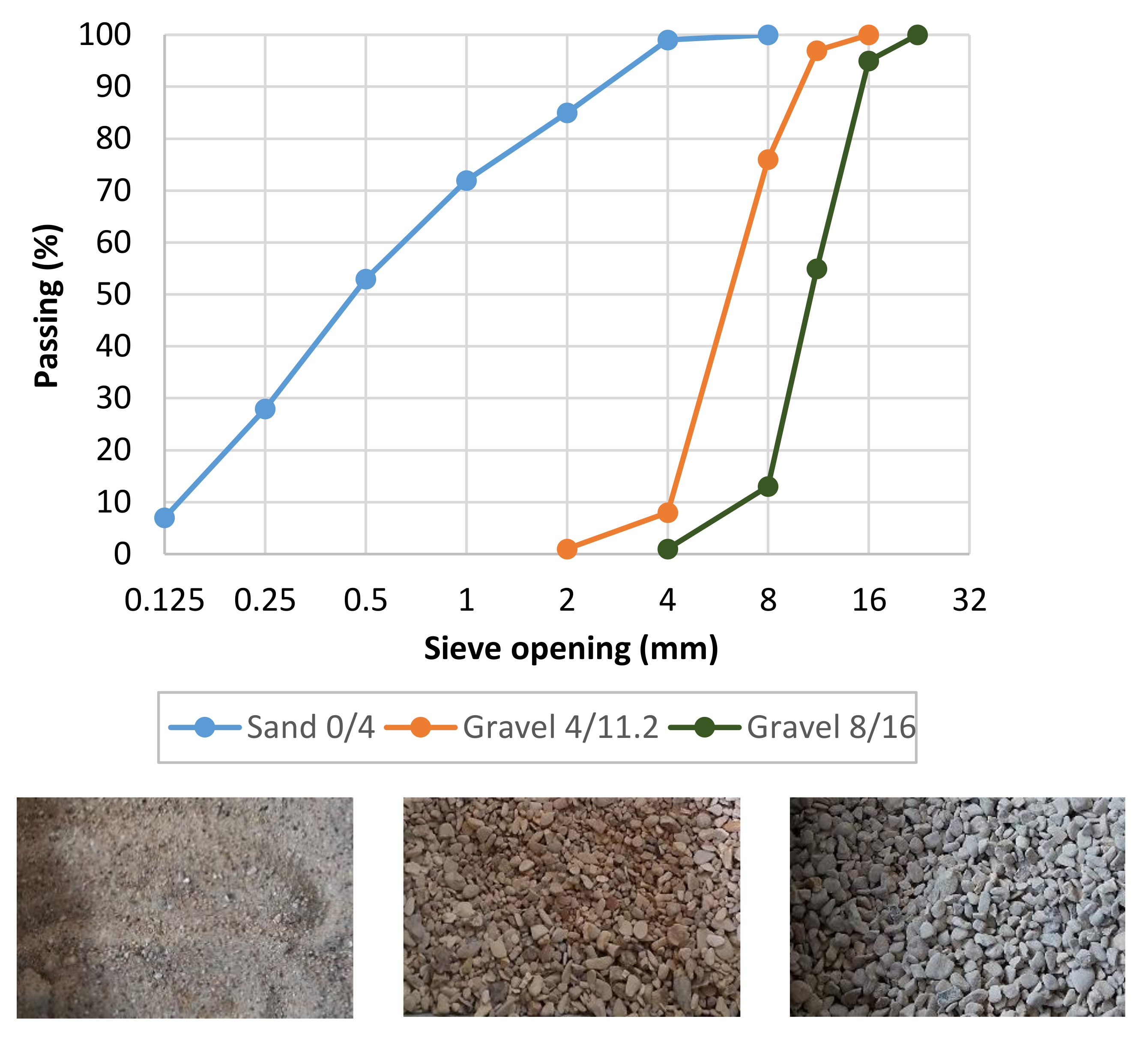
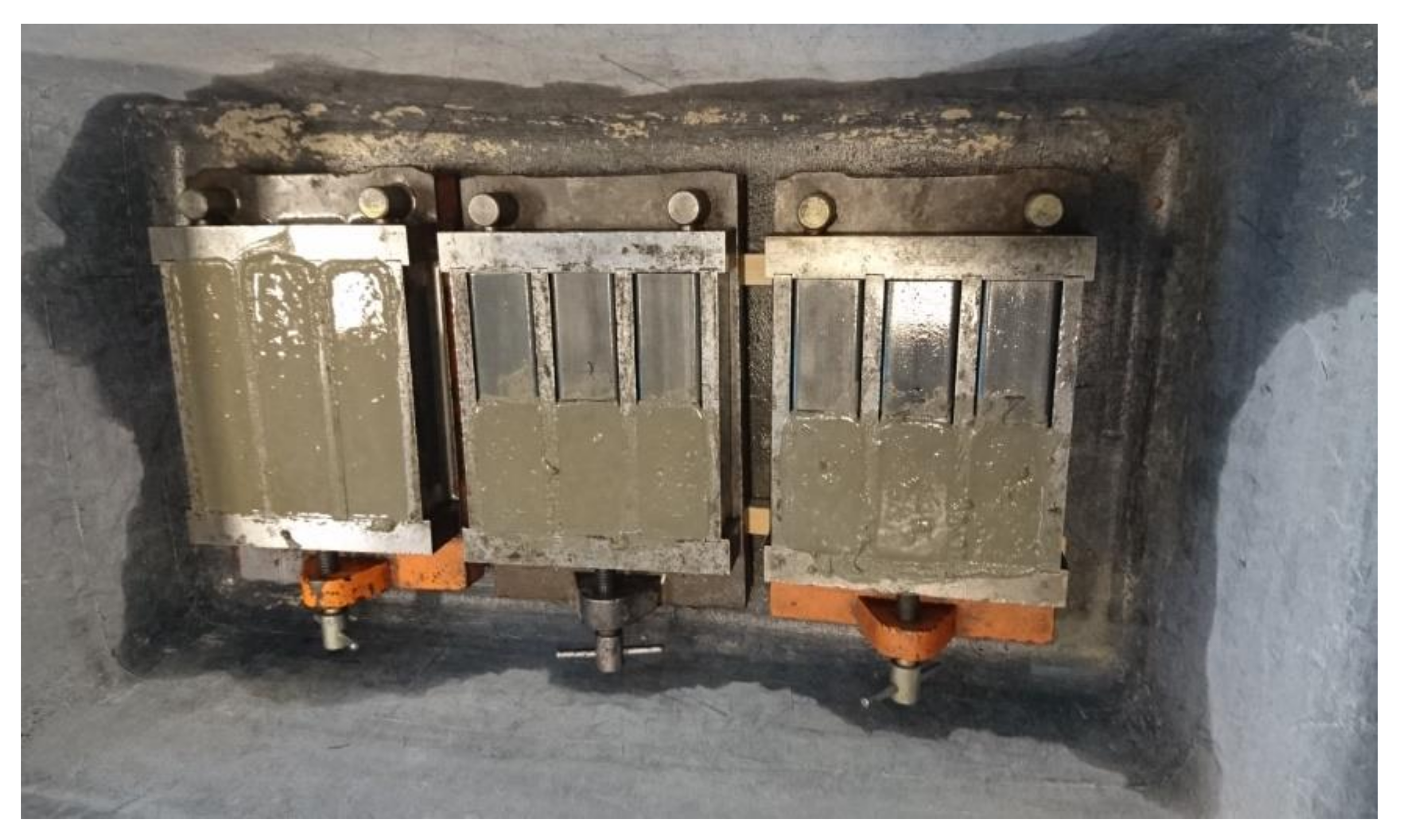
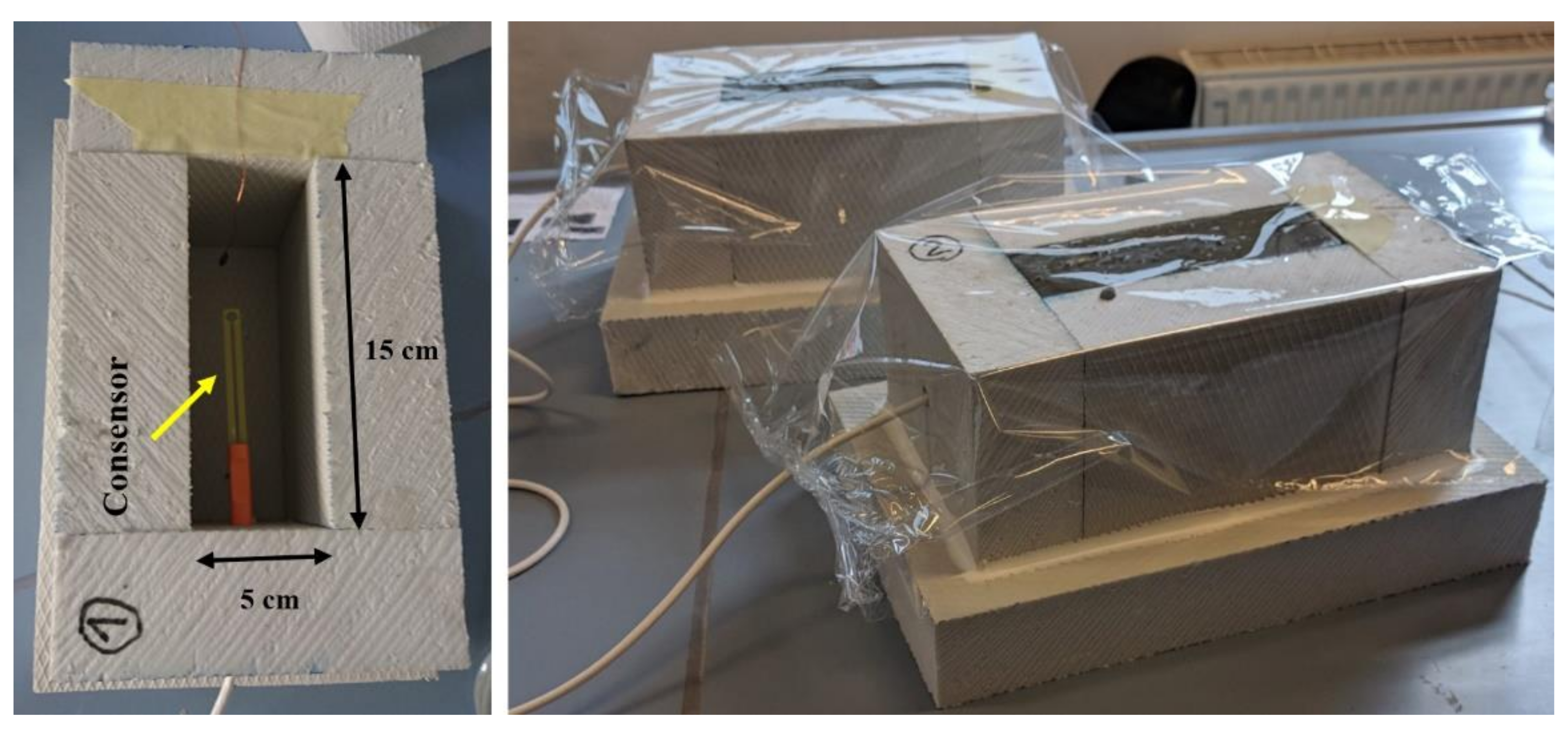
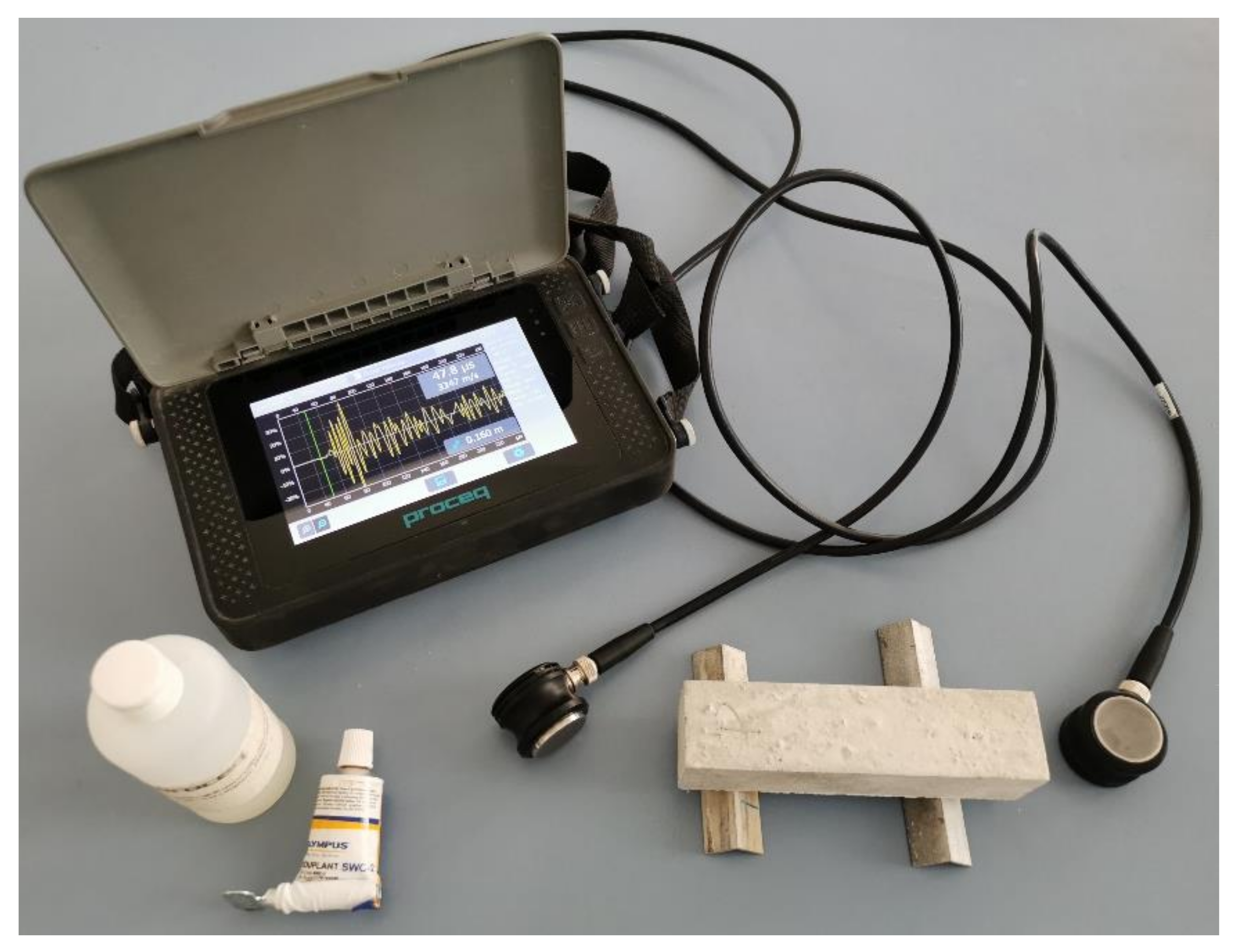
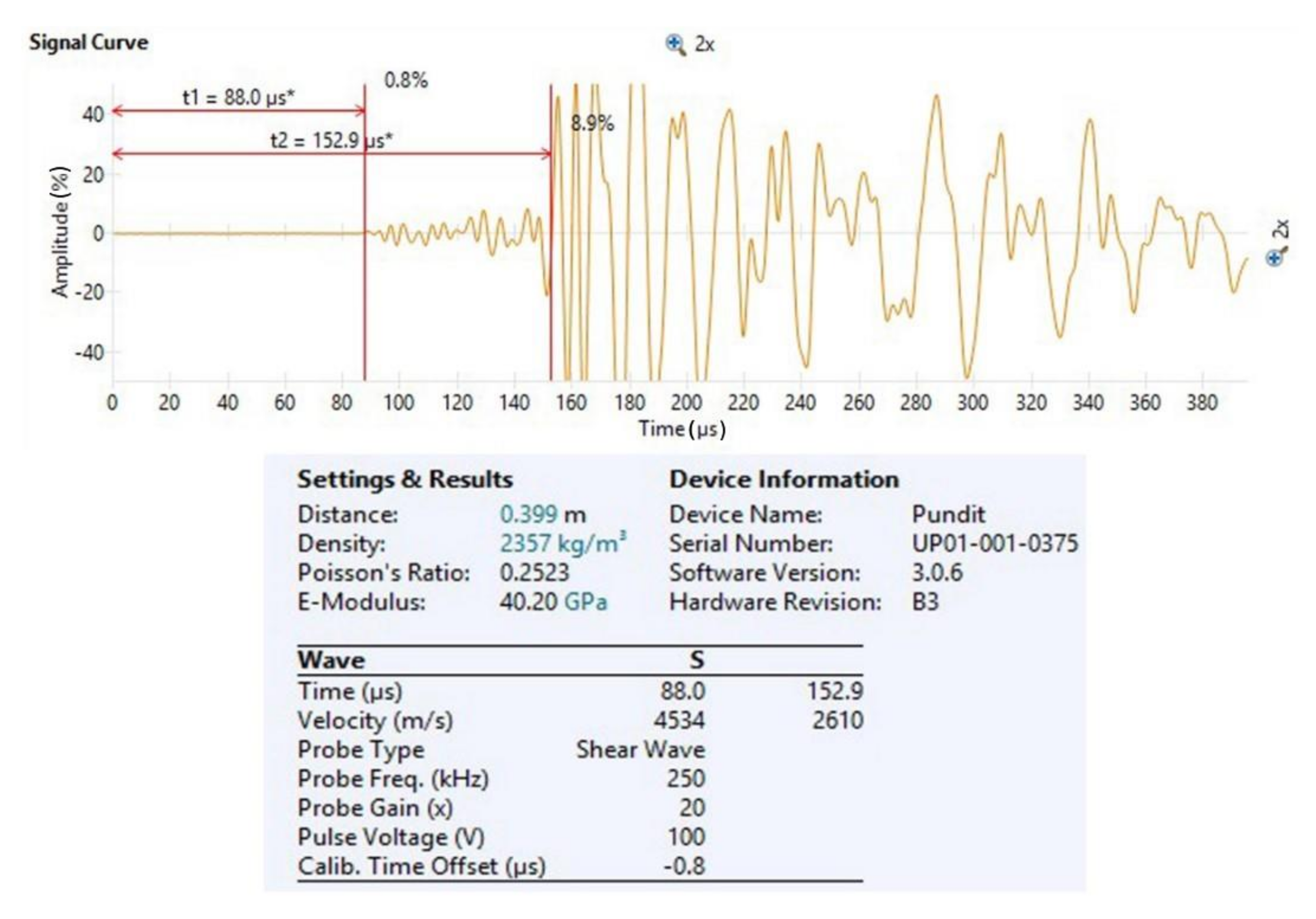
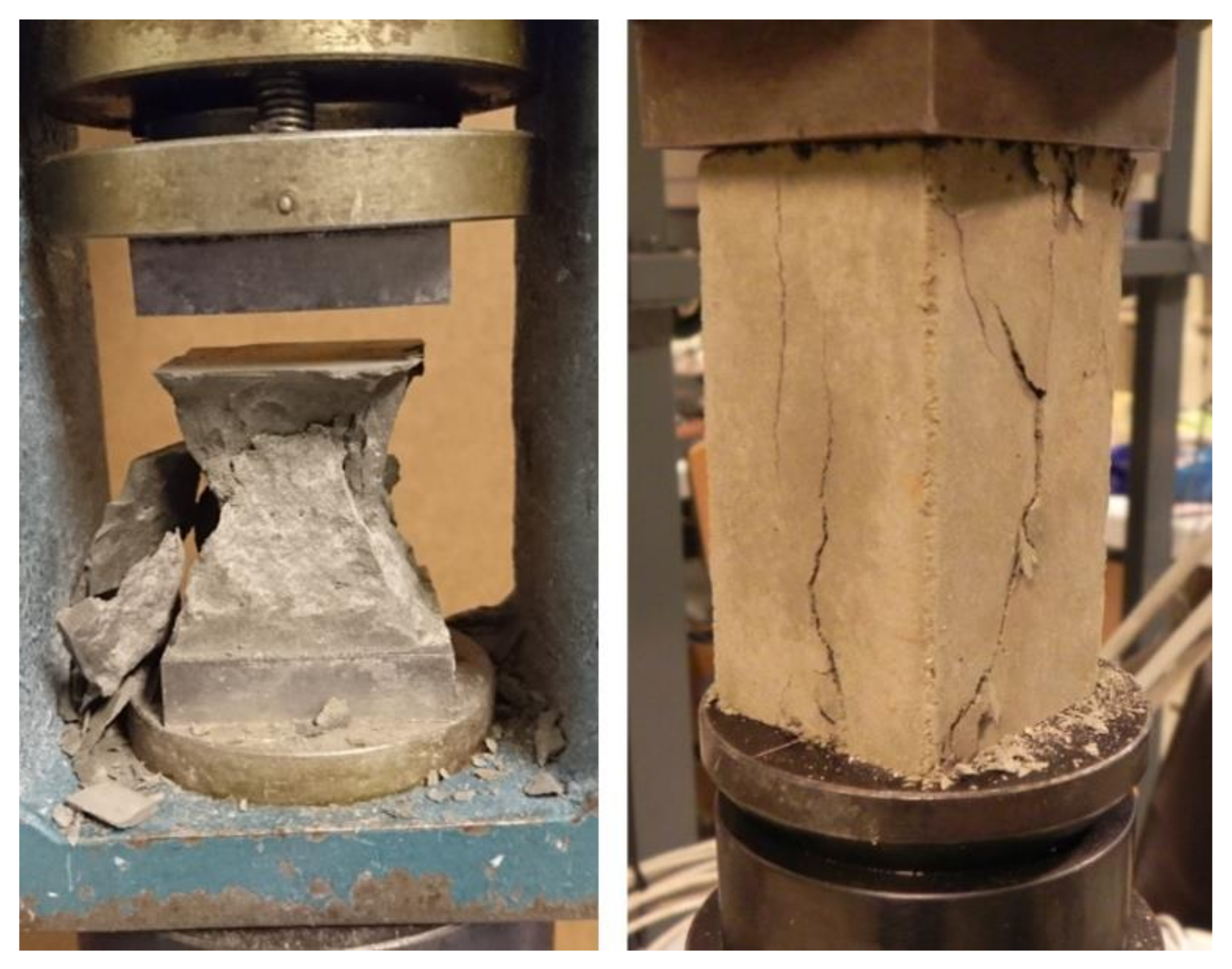
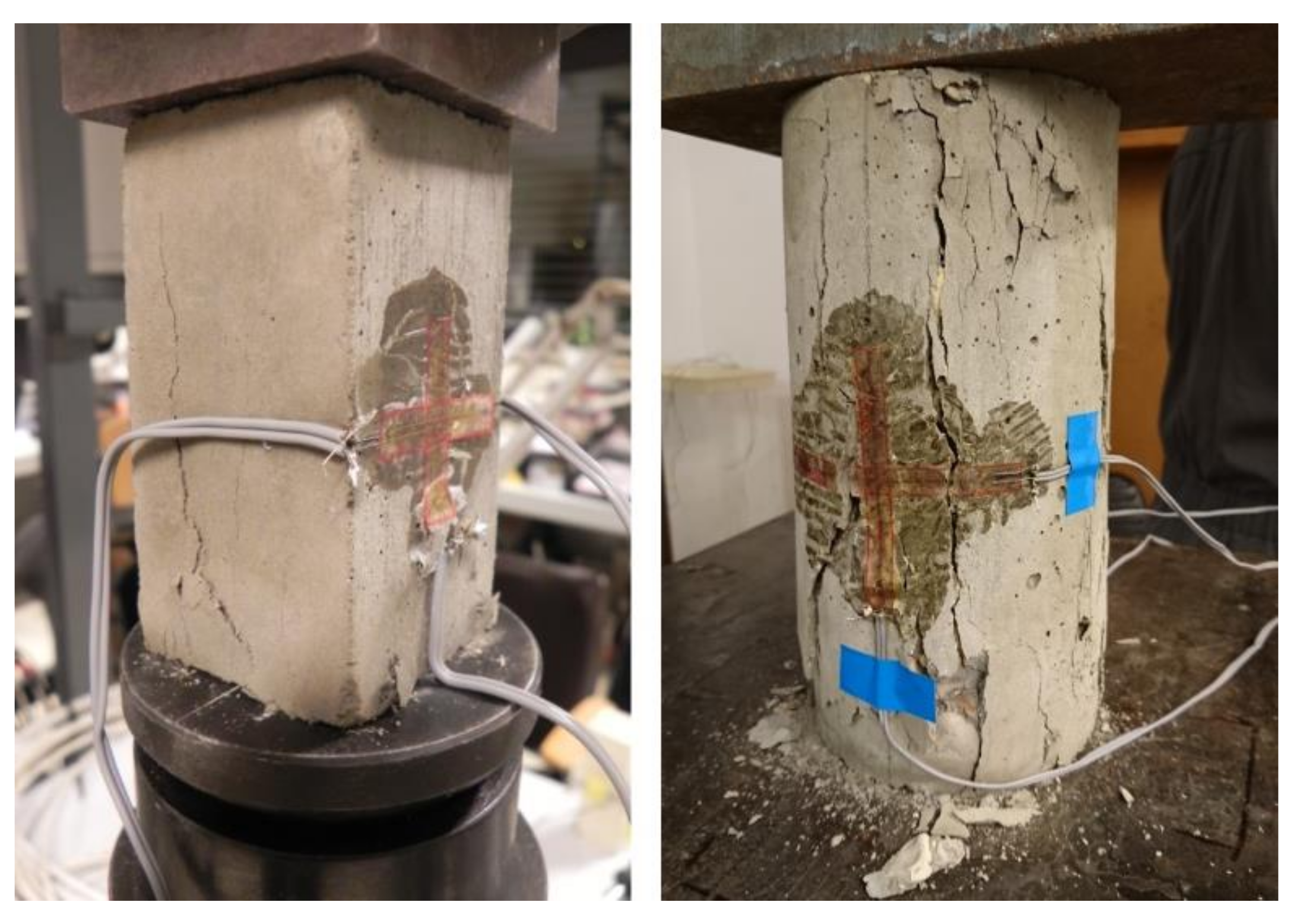

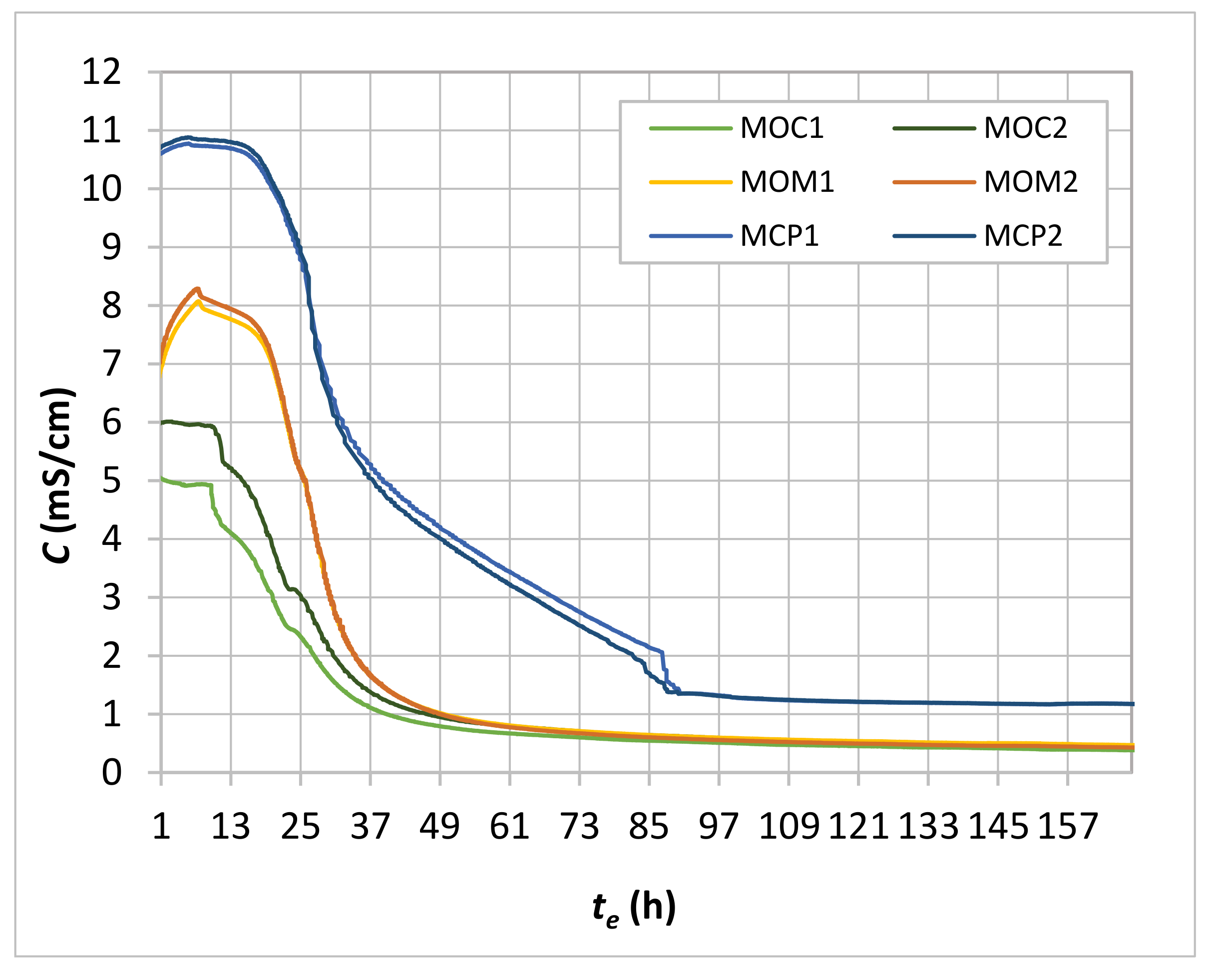
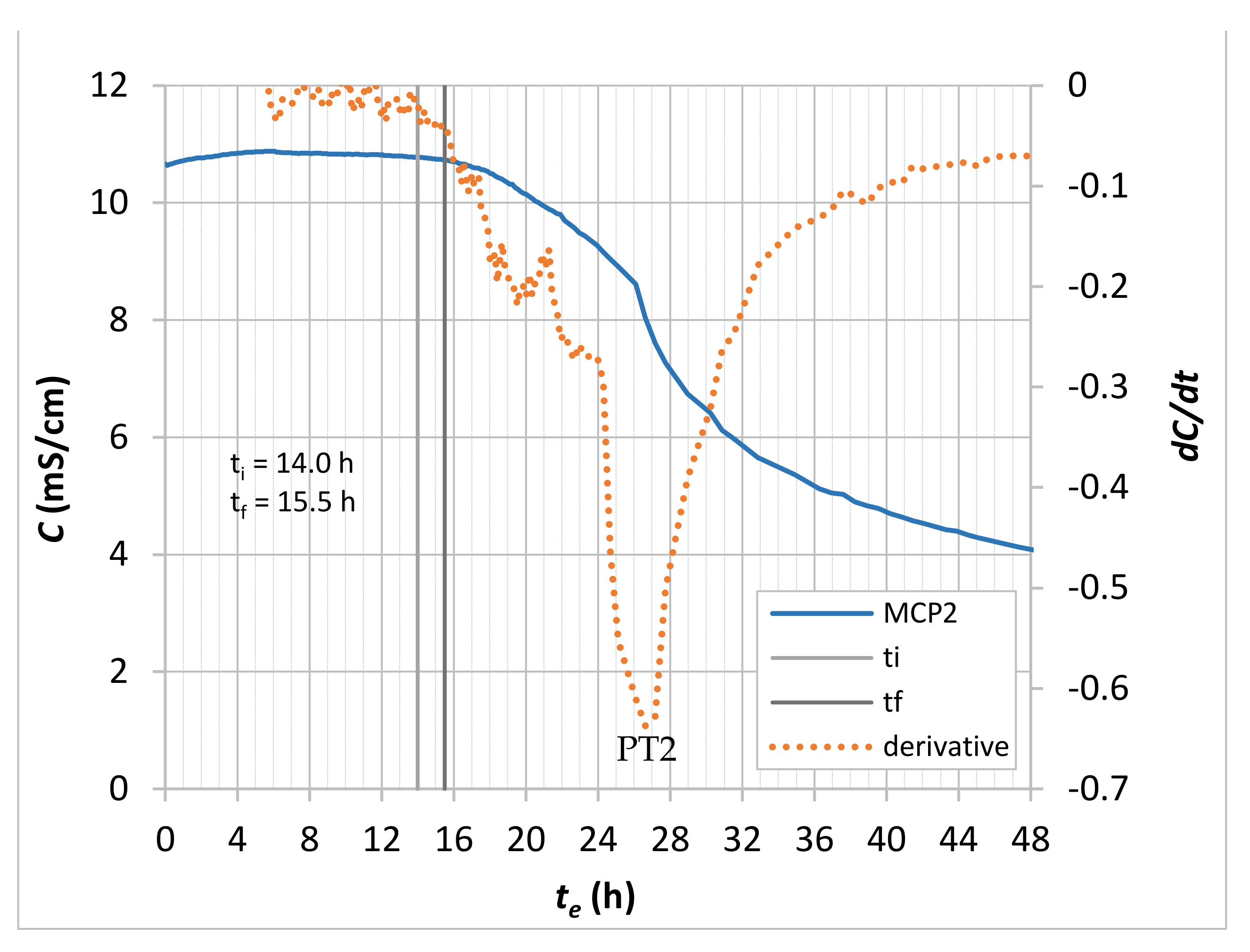
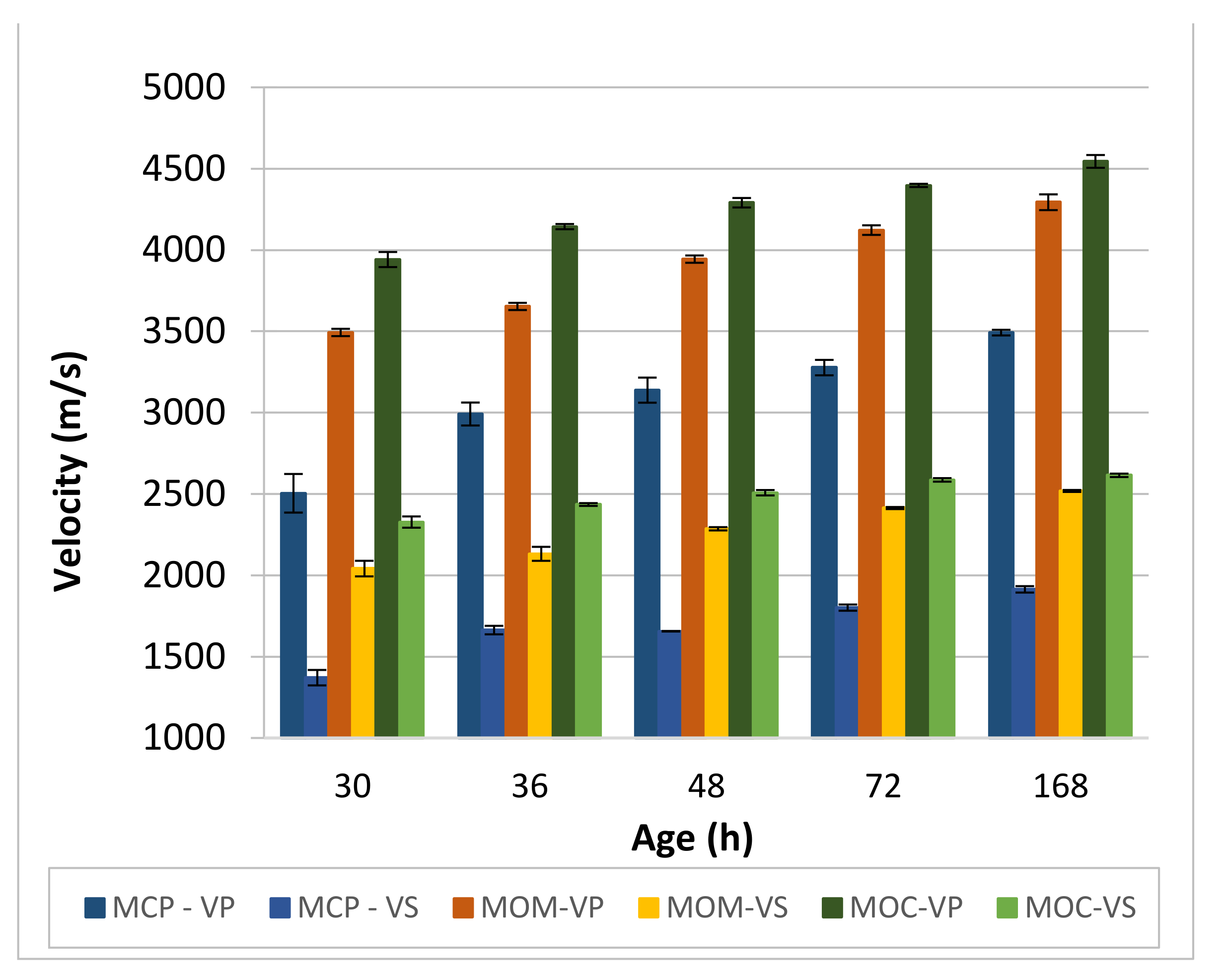

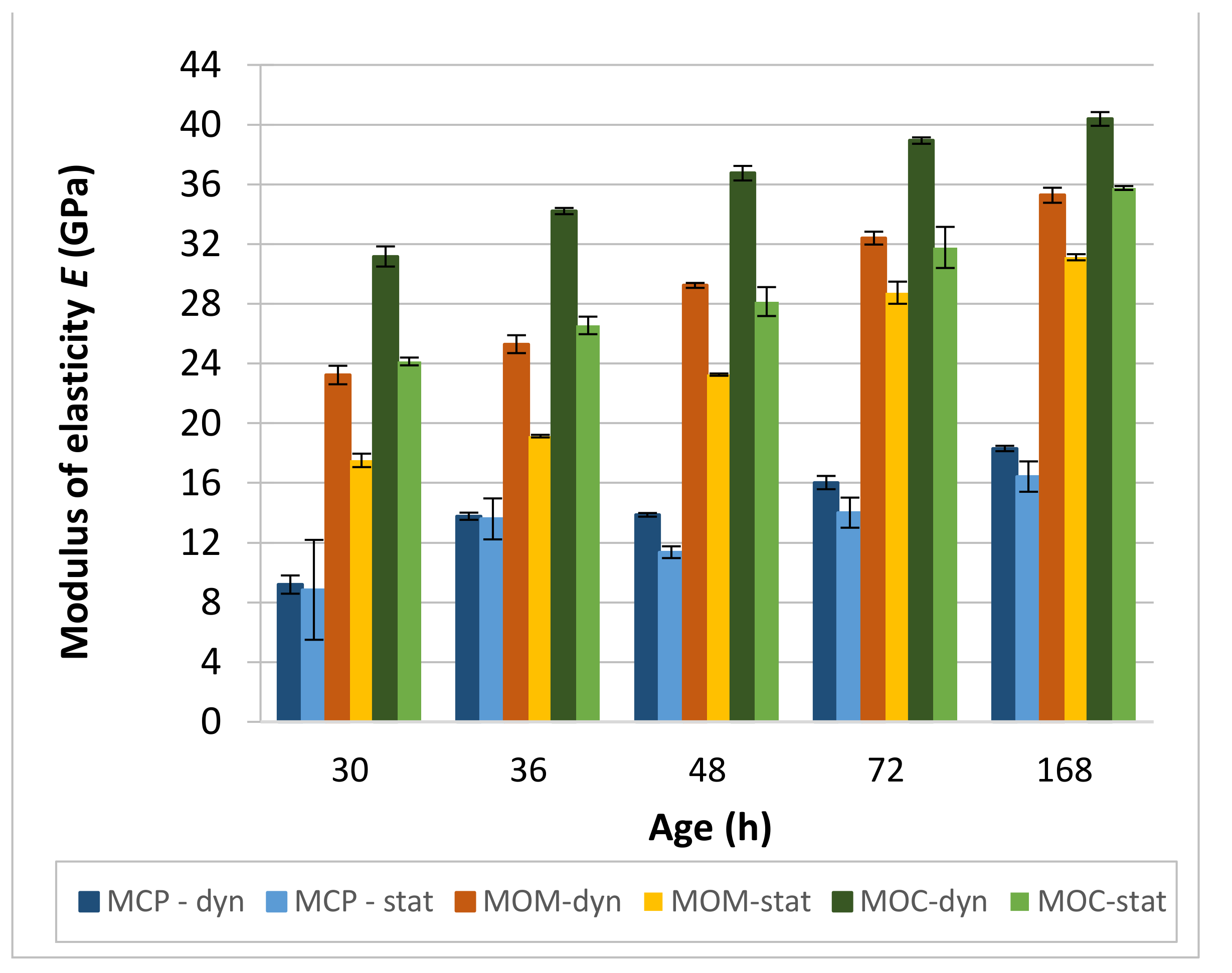
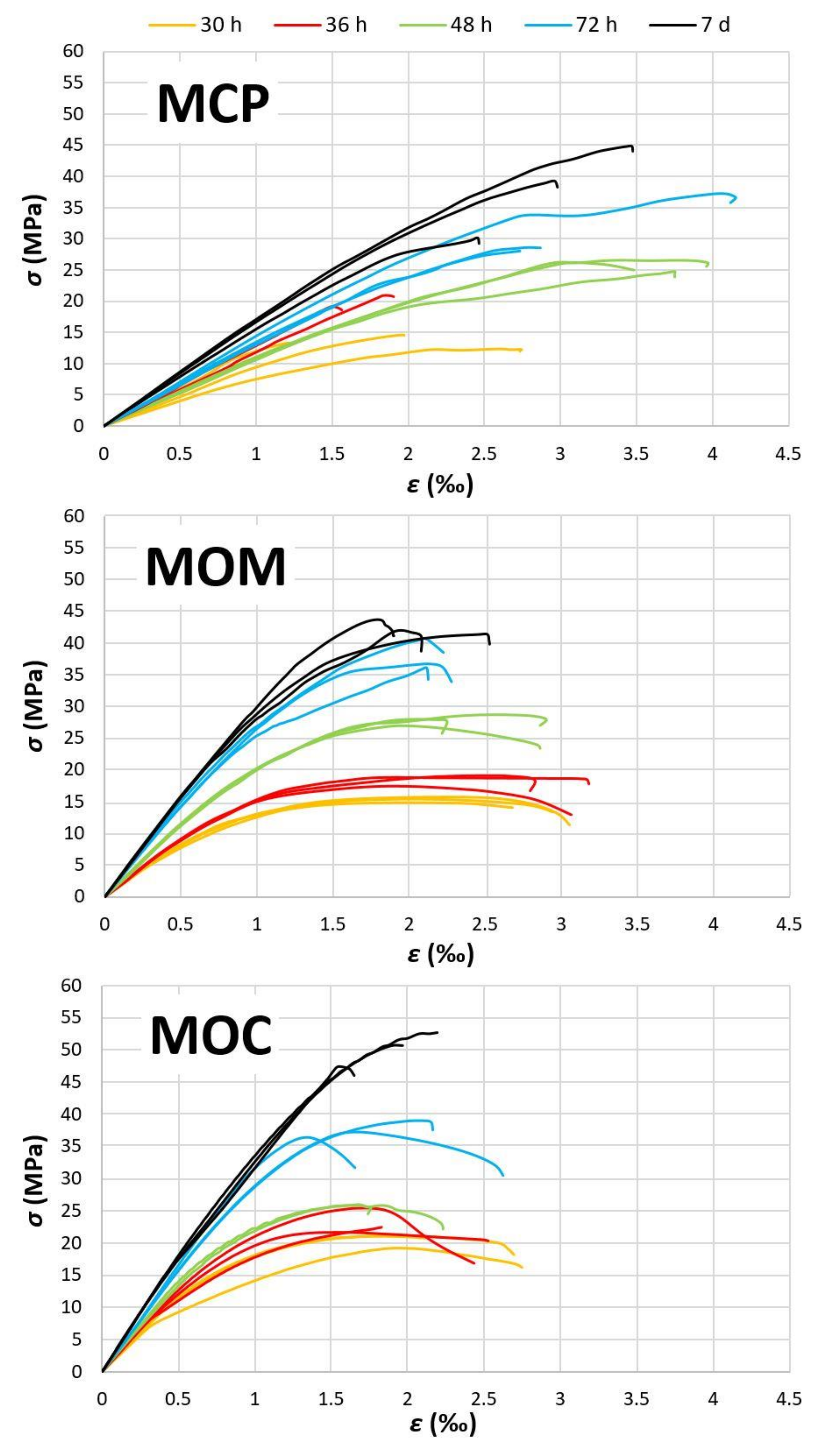
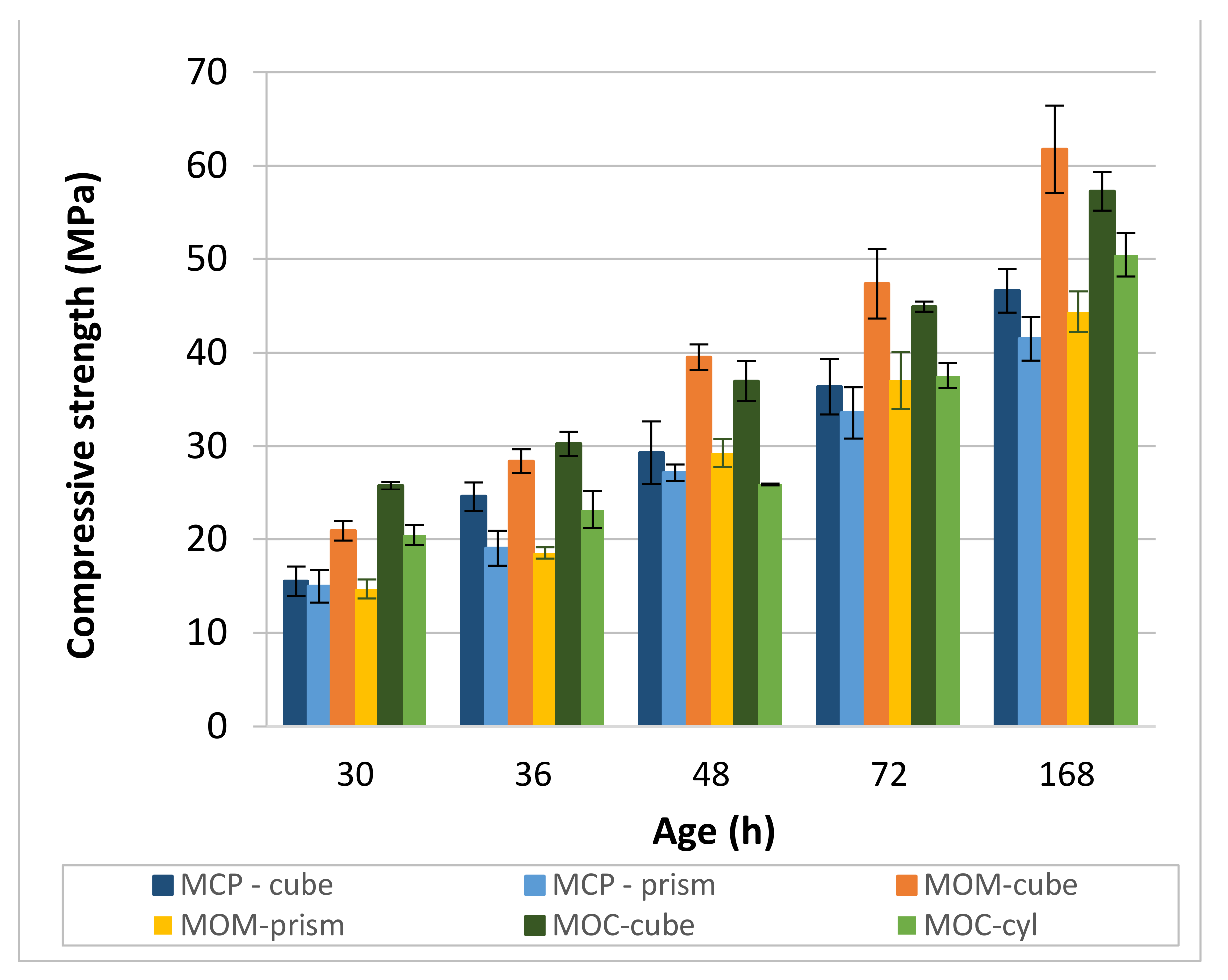
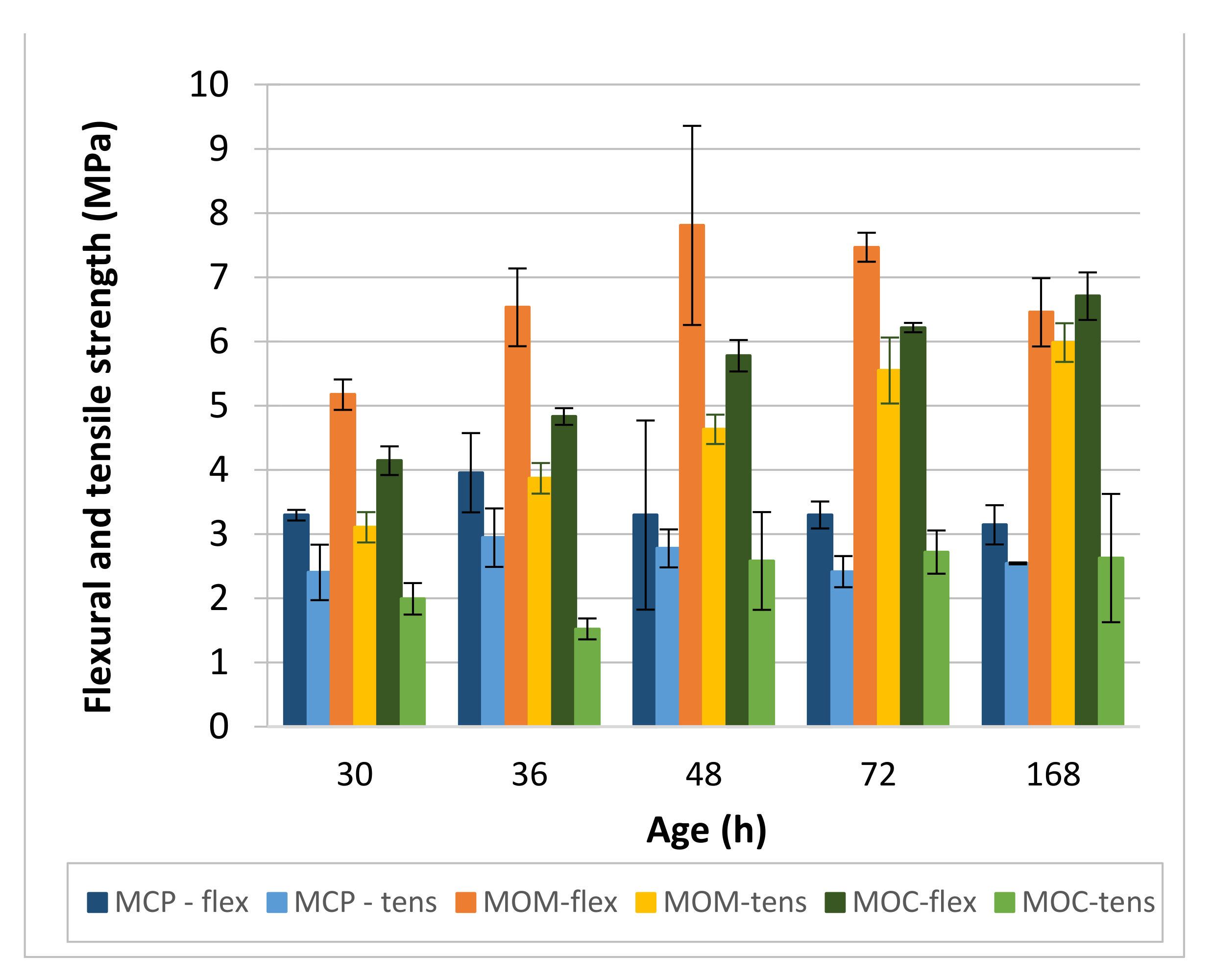
| Oxide (%) | SiO2 | CaO | MgO | Al2O3 | Fe2O3 | SO3 | Na2O | K2O | Cl |
|---|---|---|---|---|---|---|---|---|---|
| CEM I | 21.3 | 63.8 | 1.9 | 3.5 | 4.3 | 2.7 | 0.09 | 0.59 | 0.05 |
| Basic Material | Type of the Material | MCP (kg/m3) | MOM (kg/m3) | MOC (kg/m3) |
|---|---|---|---|---|
| Cement | CEM I 52.5 N | 1299 | 689 | 439 |
| Dry sand | 0–4 mm | \ | 1212 | 772 |
| Fully saturated gravel | 4–11 mm | \ | \ | 525 |
| 8–16 mm | \ | \ | 424 | |
| Admixtures | Superplasticizer | 5.85 | 5.85 | 3.73 |
| Added water * | Tap water | 514.8 | 280.1 | 178.4 |
| weff/c | 0.4 | |||
| Fresh Properties of CBM’s | Temperature of Mixture | Flow Value | Density |
|---|---|---|---|
| (°C) | (mm) | (kg/m3) | |
| MCP | 19.9 | 309 | 1923 |
| MOM | 20.1 | 236 | 2254 |
| Mixture: | Temperature of Mixture | Air Content | Flow Value | Slump Value | Density |
|---|---|---|---|---|---|
| (°C) | (%) | (mm) | (mm) | (kg/m3) | |
| 30 h | 19.6 | 2.65 | 505 | 250 | 2370 |
| 36 h | 18.5 | 2.7 | 535 | 250 | 2400 |
| 48 h | 20.2 | 2.65 | 565 | 250 | 2390 |
| 72 h | 19.9 | 2.6 | 525 | 254 | 2360 |
| 7 d | 18.8 | 2.6 | 530 | 250 | 2380 |
| Time Periods of the Hydration Process | MCP | MOM | MOC |
|---|---|---|---|
| Initial setting time (h) | 13.2; 14.0 | 14.0 | 9.5 |
| Final setting time (h) | 14.8; 15.5 | 15.5 | 11.0 |
| End of the solidification process acceleration stage—PT2 (h) | 26; 26.5 | 26.5; 27 | nd |
Publisher’s Note: MDPI stays neutral with regard to jurisdictional claims in published maps and institutional affiliations. |
© 2021 by the authors. Licensee MDPI, Basel, Switzerland. This article is an open access article distributed under the terms and conditions of the Creative Commons Attribution (CC BY) license (http://creativecommons.org/licenses/by/4.0/).
Share and Cite
Klun, M.; Bosiljkov, V.; Bokan-Bosiljkov, V. The Relation between Concrete, Mortar and Paste Scale Early Age Properties. Materials 2021, 14, 1569. https://doi.org/10.3390/ma14061569
Klun M, Bosiljkov V, Bokan-Bosiljkov V. The Relation between Concrete, Mortar and Paste Scale Early Age Properties. Materials. 2021; 14(6):1569. https://doi.org/10.3390/ma14061569
Chicago/Turabian StyleKlun, Martin, Vlatko Bosiljkov, and Violeta Bokan-Bosiljkov. 2021. "The Relation between Concrete, Mortar and Paste Scale Early Age Properties" Materials 14, no. 6: 1569. https://doi.org/10.3390/ma14061569
APA StyleKlun, M., Bosiljkov, V., & Bokan-Bosiljkov, V. (2021). The Relation between Concrete, Mortar and Paste Scale Early Age Properties. Materials, 14(6), 1569. https://doi.org/10.3390/ma14061569





